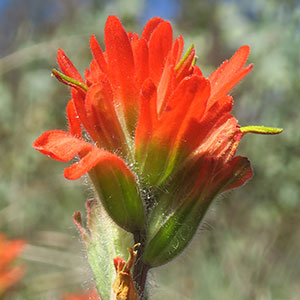Castilleja brevilobata
Castilleja dissitiflora
short-lobed paintbrush
Mount Hamilton paintbrush, Mt. Hamilton Indian paintbrush
solitary or few, erect or ascending, unbranched, sometimes branched, hairs spreading, short, medium, and long, soft, short and medium ones short stipitate-glandular.
several to many, erect to ascending, unbranched, sometimes branched, hairs spreading, long, soft, mixed with shorter stipitate-glandular ones.
green or ± yellow, lanceolate, elliptic, or oblong to narrowly ovate, 1–2(–2.5) cm, not fleshy, margins plane or wavy, involute, (0–)3–5(–7)-lobed, apex rounded to acute;
lobes ascending to erect, linear to lanceolate, apex rounded to acute.
green, linear to narrowly or broadly lanceolate, (1–)3–5(–6) cm, not fleshy, margins wavy (obscure on many pressed specimens), involute, usually 0–3(–5)-lobed, apex broadly acute to rounded;
lobes widely spreading, linear to narrowly lanceolate, apex acute to acuminate.
3–20 × 2–3.5 cm;
bracts proximally greenish to dull brown, distally red, orange-red, or scarlet, sometimes orange or yellow, broadly lanceolate or oblong, (0–)3–5-lobed;
lobes ascending, broadly to narrowly lanceolate, short, arising above mid length, apex acute, obtuse, or rounded.
2.5–10 × 2–5.5 cm;
bracts proximally greenish, distally red to red-orange, narrowly lanceolate to broadly lanceolate, 3–5-lobed;
lobes spreading, distal, if present, ascending, linear or narrowly oblanceolate to triangular, proximals long, arising below mid blade, distals short, sometimes mere teeth, near apex of central lobe, sometimes wavy-margined, apex obtuse to rounded, sometimes acute.
straight, 15–24(–26) mm;
tube 12–16 mm;
beak exserted, abaxial lip equal to calyx;
beak adaxially green or ± yellow-green, 7–10 mm, puberulent, stipitate-glandular;
abaxial lip deep green, reduced, rounded, 1–2 mm, 10–25% as long as beak;
teeth incurved to erect, light green, 0.5–1 mm.
straight to slightly curved, 24–38 mm;
tube 14–21 mm;
beak exserted from calyx, adaxially green, 11–16.5(–18) mm;
abaxial lip green, reduced, visible or not through deep front cleft in calyx, 2 mm, 13% as long as beak;
teeth incurved, green, 1 mm.
green or whitish with green veins, lobes colored as bract lobes or paler, 14–30 mm;
abaxial and adaxial clefts 5.5–8.5 mm, 30–40% of calyx length, deeper than laterals, lateral 1.5–4 mm, 20–25% of calyx length;
lobes oblong to narrowly triangular, apex obtuse to rounded.
whitish with green veins or green, sometimes purple, distally same color as bracts, sometimes with yellowish band below colored apices, 20–26(–29) mm;
abaxial clefts (8–)13–16(–19) mm, adaxial 7–12(–14) mm, clefts 35–50% of calyx length, deeper than laterals, lateral 2–6(–8) mm, 10–30% of calyx length;
lobes linear-lanceolate to lanceolate, apex obtuse to acute.
= 24.
= 48.
Castilleja brevilobata
Castilleja dissitiflora
Castilleja brevilobata is endemic to dry serpentine openings in the Siskiyou Mountains of southwestern Oregon and adjacent California. Although sometimes treated as part of C. applegatei or C. hispida, its morphology does not suggest a close connection with either. This species occasionally hybridizes with C. pruinosa in Del Norte County, California.
(Discussion copyrighted by Flora of North America; reprinted with permission.)
Castilleja dissitiflora is endemic to several mountain ranges in central and eastern Nevada, in the upper montane and lower subalpine zones. It has the deep abaxial calyx cleft of C. linariifolia and the stipitate-glandular, wavy-margined leaves of C. applegatei var. pinetorum. Based on morphological data, Holmgren suggested that it is an allopolyploid derived from hybridization of C. applegatei var. pinetorum and C. linariifolia. His proposal is plausible and should be further tested. Castilleja dissitiflora is a tetraploid, while both putative parental species have at least some diploid populations.
(Discussion copyrighted by Flora of North America; reprinted with permission.)


